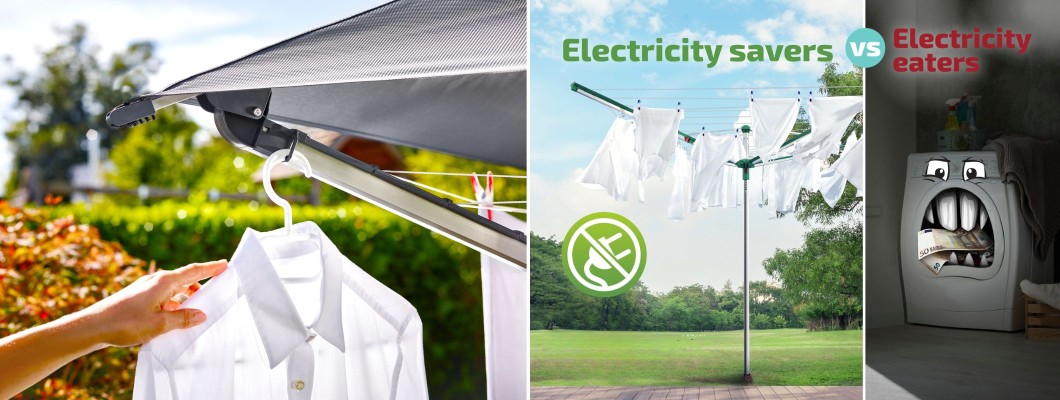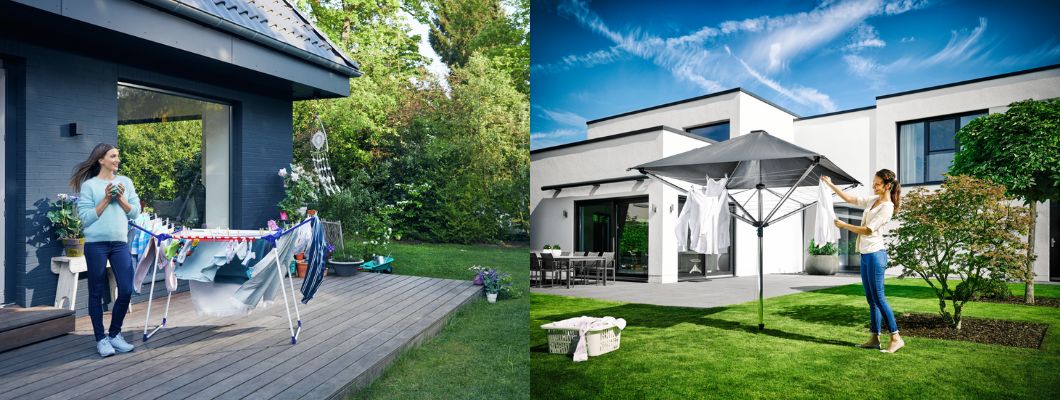
How to handle clothes to avoid damaging them
Drying clothes, especially indoors, can be quite a challenge: they don't dry properly in damp weather, placing them on radiators causes them to overheat, and figuring out how
to get a large bedsheet dry seems like an impossible mission. In this article, we will reveal common mistakes made when drying laundry and learn how to avoid them.
Believe it or not, this everyday task has its tricks that many are unaware of. Here are six commonly made mistakes and misconceptions about drying clothes.

1. DO NOT LEAVE WET CLOTHES IN THE WASHING MACHINE
You put the laundry in to wash, got caught up in daily tasks, and as a result, the washed clothes have been "lounging around" in the washing machine for three hours. Familiar scene,
isn't it? It may seem like a small detail, but during this time, the clothes can wrinkle and develop stubborn creases. Therefore, if you ever forget, it's better to first set the washing
machine to a short rinse cycle and immediately remove the laundry afterwards.
2. DO NOT OVERDRY THE CLOTHES
Overdried clothes are uncomfortably stiff to the touch, rigid as a board, and very resistant to ironing. Therefore, it's better to occasionally check the situation on the clothesline and
promptly remove the dried items. This advice is particularly relevant when drying clothes in the bathroom on a towel rack.
3. DO NOT HANG CLOTHES ON RADIATORS
This drying method can irreversibly damage your favorite clothing items. Overly hot radiators, especially if they are non-adjustable, can cause deformation of the garments and even
melt decorative appliques, causing them to peel off or stick to the hot radiator surface.
4. DO NOT DRY CLOTHES ON ELECTRIC HEATERS
This mistake can be particularly costly - the commonly adopted drying method can be dangerous not only to the clothes but also potentially cause a fire.
5. DO NOT CROWD THE CLOTHES TOGETHER
It's better not to try to save space on the clothesline because the logic is quite simple - the tighter you pack the clothes, the longer they will take to dry. To avoid this hassle, it's better
to spread out the laundry with gaps, smoothing out each garment on the clothesline to prevent the formation of creases while drying.
6. DO NOT DRY CLOTHES IN THE KITCHEN
Firstly, it should not be done for safety reasons, especially if the clothes are planned to be hung near the stove. And secondly, because the garments will quickly absorb kitchen odors,
and instead of your favorite scent, you'll end up smelling like cutlets and cabbage soup.
7. DO NOT USE OUTDATED LAUNDRY DRYING EQUIPMENT
Many still use the old-fashioned "life hack" of hanging the washed laundry on ropes stretched across the backyard or balcony. This method has several drawbacks: firstly, the ropes are
almost impossible to tighten properly - they sag under the weight of the laundry, causing the clothes to wrinkle. Secondly, over time, the ropes become dirty and can leave unsightly marks
on the clothes. Additionally, if it rains, drying clothes on ropes outside becomes an endless process.
Fortunately, nowadays there are much more convenient solutions available. For example, with the sophisticated technology of the Leifheit rotary clothesline, you can dry clothes very
conveniently, quickly, and easily: it can be easily opened and closed, equipped with a roof that protects the clothes from rain/sun, and special tensioning technology ensures that
the clothesline is always taut. In addition to the simple control of the clothesline, it has another wonderful feature - an automatic mechanism for retracting the clothesline.
Thanks to this, when not in use, the clothesline is always stored in the support system, and it remains clean. Considering that the length of one side of the clothesline is 2.2m,
it is suitable for drying even large-sized items such as sheets and blankets.
What to Consider When Drying Clothes Indoors

If possible and the weather permits, place the clothes dryer near an open window. This way, the clothes will dry faster while also allowing for ventilation. Fresh air also has a positive
impact on the microclimate of the room.
If you're drying clothes in the bathroom, remember to turn on the ventilation or floor heating, or at least leave the bathroom door open. This will help the clothes dry faster while
preventing excess moisture from accumulating on the walls and ceiling.
Try to develop a habit of removing the dry clothes from the dryer, immediately folding them, and storing the dryer in its designated place to avoid using it as a makeshift hanger.
Nowadays, there are convenient and "smart" clothes dryers available in the market that can significantly simplify this task. Perhaps it's time to consider getting a new assistant for yourself?
WHAT SHOULD AN IDEAL CLOTHES DRYER BE LIKE:

• High-quality – sturdy construction;
• Convenient and compact – easily foldable or collapsible, taking up minimal space when stored;
• Lightweight yet durable and stable – it should not wobble or tip over.


9 Comment(s)
It’s a great way to define and simply amazing. I must prefer to visit your site again.
Thiết kế trang web rất phù hợp với thẩm mỹ hiện đại, vừa đẹp vừa dễ sử dụng.
Tôi rất thích các trò chơi trên FB88, luôn có những sự kiện thú vị để tham gia.
Chức năng của nền tảng rất ổn định, gần như không có hiện tượng giật lag.
LG VINA COSMETICS CO., LTD., established in 1997, takes pride in bringing renowned cosmetic brands and premium home and personal care brands to Vietnamese customers. We currently operate in two main categories: Beauty and HDB (Home Care and Daily Beauty). The Beauty category includes products from skincare, cosmetics, and functional food groups, while the HDB category covers products in home care and daily personal care groups. With a vision to become a leading company in the beauty and health industry, we are meticulous at every stage of management to ensure that our products are of the highest quality and meet customer needs.
15 Lê Quang Định, Phường 9, Vũng Tàu, Bà Rịa - Vũng Tàu 792683, Việt Nam
LiveBet là một nền tảng giải trí trực tuyến sáng tạo, cung cấp cược thể thao trực tiếp và nhiều tính năng tương tác. Dù bạn là fan của bóng đá, bóng rổ hay các giải đấu eSports, LiveBet đều mang đến cho bạn trải nghiệm cược hấp dẫn. Với hệ thống cập nhật tỷ lệ cược nhanh chóng, bạn có thể cược trong suốt trận đấu và tận dụng mọi cơ hội chiến thắng. Các phương thức thanh toán an toàn và dịch vụ khách hàng 24/7 đảm bảo bạn chơi mà không lo lắng. Tham gia LiveBet ngay hôm nay để trải nghiệm cược trực tuyến tiên tiến nhất!
LiveBet là một nền tảng giải trí trực tuyến sáng tạo, cung cấp cược thể thao trực tiếp và nhiều tính năng tương tác. Dù bạn là fan của bóng đá, bóng rổ hay các giải đấu eSports, LiveBet đều mang đến cho bạn trải nghiệm cược hấp dẫn. Với hệ thống cập nhật tỷ lệ cược nhanh chóng, bạn có thể cược trong suốt trận đấu và tận dụng mọi cơ hội chiến thắng. Các phương thức thanh toán an toàn và dịch vụ khách hàng 24/7 đảm bảo bạn chơi mà không lo lắng. Tham gia LiveBet ngay hôm nay để trải nghiệm cược trực tuyến tiên tiến nhất!
Trường Tiểu học Nguyễn Trung Trực được thành lập năm 1985 có địa chỉ tại 9A Phạm Hồng Thái, phường Nguyễn Trung Trực, quận Ba Đình, Hà Nội (Nay thành phường Trúc Bạch). Trường hoạt động dưới sự quản lý của UBND quận Ba Đình và Phòng Giáo dục và Đào tạo Ba Đình. Trường được xây dựng khang trang trên diện tích hơn 3000 m2 với đủ các phòng học và phòng chức năng cho các hoạt động học tập, vui chơi, giải trí của học sinh.
Địa chỉ: Số 9A Phạm Hồng Thái - Ba Đình - Hà Nội
Email: [email protected]
website: Https://s666s666s.com/
Điện thoại: 438261441
Trường Tiểu học Nguyễn Trung Trực được thành lập năm 1985 có địa chỉ tại 9A Phạm Hồng Thái, phường Nguyễn Trung Trực, quận Ba Đình, Hà Nội (Nay thành phường Trúc Bạch). Trường hoạt động dưới sự quản lý của UBND quận Ba Đình và Phòng Giáo dục và Đào tạo Ba Đình. Trường được xây dựng khang trang trên diện tích hơn 3000 m2 với đủ các phòng học và phòng chức năng cho các hoạt động học tập, vui chơi, giải trí của học sinh.
Địa chỉ: Số 9A Phạm Hồng Thái - Ba Đình - Hà Nội
Email: [email protected]
website: Https://s666s666s.com/
Điện thoại: 438261441
Ļoti vērtīgi padomi! Noteikti noderēs ikvienam, kurš vēlas pasargāt savas drēbes un ietaupīt laiku, žāvējot veļu gudri un droši. Paldies par rakstu!
Leave a Comment